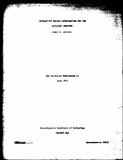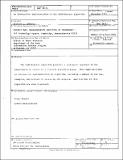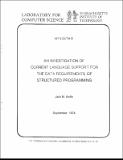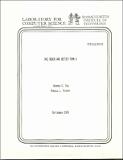Browsing LCS Publications by Title
Now showing items 570-589 of 1163
-
Interactive Computer-mediated Animation
(1969-06)The use of interactive computer graphics in the construction of animated visual displays is investigated. The dissertation presents a process called interactive computer-mediated animation, in which dynamic displays are ... -
Interactive Design Coordination for the Building Industry
(1970-06)The problem of effective communication in the process of building design and construction is widely recognized. The involvement of several design disciplines combined with the tendency for designers to work in distinct ... -
An Interactive Implementation of the ToddCoxeter Algorithm
(1973-12)The Todd-Coxeter algorithm provides a systematic approach to the enumeration of cosets of a finitely presented group. This memo describes an interactive implementation of algorithm, including a manual on its use, examples, ... -
An Interactive Programming System for Media Computation
(1994-09)As digital video is manipulated by increasingly powerful computers, many new applications are becoming viable. This report investigates the programming language aspects of controlling such video applications. It presents ... -
An Interchange Standard and System for Browsing Digital Documents
(1995-05)With the advent of fast global digital communication networks, information will increasingly be delivered in electronic form. In addition, as libraries become increasingly more computerized, not just card catalogs but ... -
An Intermediate Form for Data Flow Programs
(1979-11)A data flow program, often represented as a data flow graph, is a program that expresses a computation by indicating the data dependencies among operators. A data flow computer is a machine designed to take advantage of ... -
Internal Consistency of a Distributed Transaction System with Orphan Detection
(1983-01)This thesis defines a property called "view-serializability", which formalizes internal consistency for a system of nested atomic transactions. Internal consistency is a stronger condition than the usual notion of data ... -
Interprocedural Data Flow Analysis in the Presence of Pointers, Procedure Variables, and Label Variables
(1980-10)The compilation of highly modular programs requires extensive interprocedural analysis in order to produce reasonable object code. Such analysis is greatly complicated when the source language contains such constructs as ... -
Interval and Recency-rank Source Coding: Two On-line Adaptive Variable-length Schemes
(1986-04)In these schemes the encoder maps each message into a codeword in a prefix-free codeword set. In interval encoding the codeword is indexed by the interval since the last previous occurrence of that message, and the codeword ... -
Introduction to Multics
(1974-02)The Multics project was begun in 1964 by the Computer Systems Research group of M.I.T. Project MAC. The goal was to create a prototype of a computer utility. In 1965, the project became a cooperative venture of M.I.T. ... -
Introduction to the Theory of Nested Transactions
(1986-07)A new formal model is presented for studying concurrency and resiliency properties for nested transactions. The model is used to state and prove correctness of a well-known locking algorithm. -
Investigation of a Preemptive Network Architecture
(1994-05)Two network architectures, cell and packet, form the basis of most high bandwidth network research. If analyzed from the perspective of building a switch, both architectures have unique advantages. The preemptive ... -
Investigation of an Analog Technique to Decrease Pentracking Time in Computer Display
(1966-03)Many modern digital computer systems contain cathode-ray tube display equipment to facilitate man-machine communications. Through the use of a display and a light-sensitive pen, graphical material can be directly inserted ... -
An Investigation of Current Language Support for the Data Requirements of Structured Programming
(1974-09)Structured programming is a new method for constructing reliable programs. Structured programming relies upon a systematic technique of top-down development which involves the refinement of both control structures and data ... -
The IOA Simulator
(2002-07) -
K+1 Heads are Better Than K
(1976-09)There are languages which can be recognized by a deterministic (k+1)-headed one-way finite automaton but which cannot be recognized by a k-headed one-way (deterministic or non-deterministic) finite automaton. Furthermore, ... -
Knowledge and Common Knowledge in a Byzantine Environment: Crash failures
(1986-07)By analyzing the states of knowledge that the processors attain in an unreliable system of a simple type, we capture some of the basic underlying structure of such systems. In particular, we study what facts become common ... -
Knowledge Representation for Supporting Decision Model Formulation in Medicine
(1991-06)Clinical decision making involves a large, complex, and ever-changing body of knowledge. Characterizing such knowledge illuminates the representational and computational requirements for automated clinical decision analysis. -
KOLA: Knowledge Organization Language
(1988-10)The focus of this research is on a representation of knowledge that captures the structure of a domain into the computational model for efficient retrieval and reasoning. With this desideratum in mind, a concept-based ...



















